
lilo
-
Posts
474 -
Joined
-
Last visited
Content Type
Profiles
Forums
Blogs
Gallery
Events
Store
Posts posted by lilo
-
-
Hi Scott,
You should bear in mind that the medals in the funeral pillow are not all the decoration/medals/orders received by Ettore Muti. On an italian website it is mentioned that He received something as 46 awards. I don't know how much true is this affirmation but I'm trying to investigate the full medal entitlement of this Person.
Thank You for having answered one of my two question.
Anyone that can tell me what is the correct ribbon for this award ??
Many Thanks in advance
Regards
Lilo
0 -
Here is the other photo (identical ribbon used in the above miniature !)
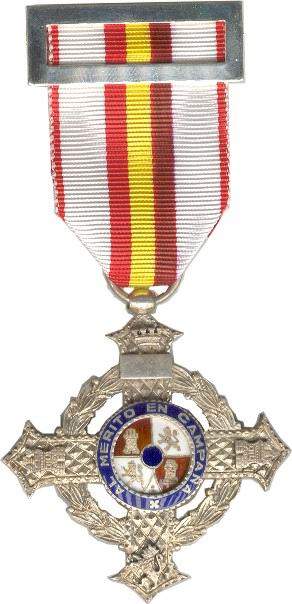 0
0 -
Hello Hipnos,
Many thanks for your detailed answer.
A couple of clarification please :
1) Ettore Muti was a Captain when he volunteered to fight in Spain becoming part of the "Tercio". On 15th of March, 1937 He was promoted Major for War Merit, a rank that He held for the duration of that conflict. Considering these ranks, which between the two 'Cruz de Guerra' showed in the 2 photos you posted above Ettore Muti received : that with the central 'red background' (on the left) or that with the central 'blue background' (on the right) ?
2) Regarding the colours of the ribbon for this 'Cruz de Guerra', you have written that it has a : 'breast ribbon (blue-white-blue)'. I please you to see the photos I attached below as both have the identical ribbon that differ from what you have said this 'Cruz de Guerra' has. Can you please specify which is the correct ribbon ??
Many Thanks
All the Best
Lilo
The 'Cruz de Guerra' in the miniature medal group below is on the extreme right
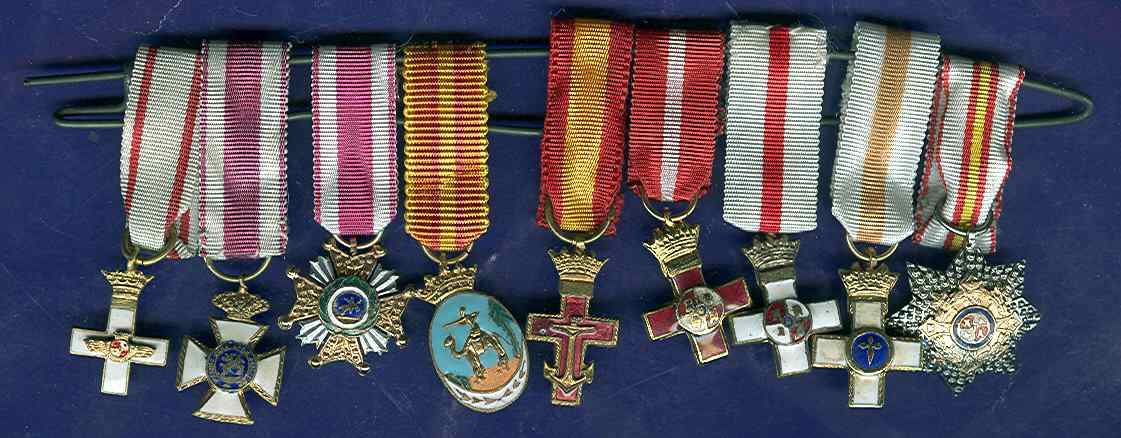 0
0 -
Dear All,
Below attached is the medal group to the most decorated Italian fighter pilot of all times : Ettore Muti.
He fought in the Spanish Civil War (1936-39).
My question is :
Is it the breast star in the up right of the medal group (that indicated with the 'Red Arrow') that of the Spain, Order of Maria Christina ?
If yes, can someone let me see which is the ribbon pertaining to this Order ?
Many Thanks in advance
Best Regards
Lilo
P.S.
As an aside it seems to me to have see this order at the following links :
- See Post #48 at http://gmic.co.uk/index.php?showtopic=34128&st=40
- See Post #85 at http://gmic.co.uk/index.php?showtopic=34128&st=80
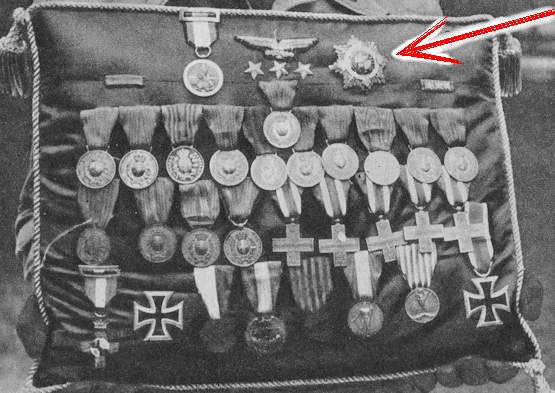
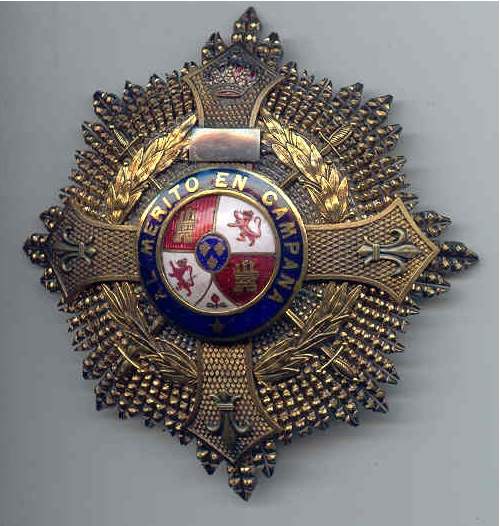 0
0 -
Hello Lilo,
Do you actually mean pre-1933?
The Greek award is listed in the Who's Who entry before the Egyptian Medal for Devotion.
Cheers,
James
Hi James,
Yes, being the Greek award listed in the Who's Who entry before the Egyptian Medal for Devotion and being this last medal awarded c. 1933 and last, supposing that the awards listed in the Who?s Who entry are in chronological order, I think that what is called ???Greek Distinguished Service medal??? was awarded pre-1933.
Many thanks for the very interesting information about the Iranian Humayun Order.
Best Regards
Lilo
0 -
Hello James,
Many thanks for your answer.
I already knew that the Who's Who entries were compiled by the same persons to which they were referred to.
I have searched the London Gazette online and have found the entries for only a part of the awards (i.e. the Egyptians, the Italian and obviously for the British). I also contacted an UK friend of mine (well known in the OMRS circuit) and he advised me that Baker was proposed for the award of the Egyptian medal for devotion in c. 1933.
Nothing was found for the others.
So, in conclusion, if your thinking is correct the 'Greek, Distinguished Service medal' was surely a post 1933 award and Not a WW1 one.
Many Thanks
Best Regards
Lilo
0 -
Hello Spiros / Megan
Many thanks for your Help.
All the Best
Lilo
0 -
Hello Hipnos / Spiros
Many thanks for your further Help.
Spiros
Sorry no photo of Baker : Unfortunately all that I was able to obtain on Baker during my research is the entry on the medal catalog, the 1920 Army List and the Who's Who entries.
So, if I well understood, the 'Greek, Distinguished Service medal' Baker was awarded with was the "Medal of Outstanding Acts" and in particular the exact type is that (on the left in your photo) that has a 'PHOENIX' instead of the King?s cypher "X II" and with black stripes + '1940' bar on its riband, isn't it ?
Many Thanks again
Best Regards
Lilo
0 -
Hello Megan, Hendrik, Emanuel, Ulsterman
You are very kind and patient persons with great knowledge : Many thanks for your precious help that I have sincerely appreciated !
Emanuel
Many thanks to have taken time in further explain your thinking/guess !
Best Regards
Lilo
0 -
Hello Ulsterman,
Many thanks for your kindness.
Can you please specify when happened this "navy revolt" in Egypt ?
Best Regards
Lilo
0 -
Here is the Merit cross , medal 4th class or distinguished service how they call it also.
http://i103.photobucket.com/albums/m133/em...OSS1916-17A.png
Hello Emanuel,
You say : 'how they call it'. Who are they ? (may be Megan and Hendrick ??)
Can you please tell me if you have only posted a photo of what Megan and Hendrik have guessed or if you, as a Greek, know for sure that the Merit cros was known in Greece ALSO as 'Distinguished Service medal' as mentioned in WHo's Who ?
I Greatly would appreciate your answer
Regards
Lilo
0 -
Hi Hendrik,
Many thanks for your guess : Mauch appreciated as well as that of Megan.
All the Best
Lilo
0 -
Hi Carol I
Many Thanks for your imput !
Best Regards
Lilo
0 -
Hello Carol I / Peter,
Many thanks for your comments.
Carol I,
How I may contact or re-search the sources you mentioned ?
Regards
Lilo
0 -
Probably the Medal of Military Merit, instituted 28 February 1917 and awarded in 4 classes for heroism and leadership in combat.
Hello Megan,
Many thanks for your guess !
May I ask you why do you think that this is the correct medal ?
I'm asking this because I have read Baker's '1920 Army List' and there is no mention of a Greek award. If He was awarded this medal for 'heroism in combat' related to WW1, I would expect to find mention of this award in the Army List and in the London Gazette, but this is not the case so I'm more inclined to think that He gained this medal during the period 1920-46 when He was in the Egyptian Police.
What is your thinking ??
Many Thanks again
Lilo
0 -
Hello Demir,
You should pardon me but I have made a great confusion on the matter, now !
Unfortunately in the 2 photos I have of Gen. Manera wearing his awards, He clearly don't wear the Ottoman medal but only the Turkish, Order of Medjie at his neck.
I have understood that it can be of great help to you for correctly identify what was the Ottoman medal 'Sega Kat' General Manera received in 1908, to describe exactly what rank Manera had and what He did in the period 1899-1911 :
"""In 1899 Gen. Cosma Manera went to Crete as a Lieutenant of the 2? Battalion / 93? Infantry.
At the end of the 1904 He was sent in Macedonia, as member of the Italian Mission to organize a local police force. He came back to Italy from Macedonia on 5th August, 1908. He became Captain in 1911."""
My questions
1) Again, bearing in mind that till 1911 He was a Lieutenant, what is more probable that he received as Ottoman medal : the Liyakat medal or the IMTIYAZ MEDAL ?
2) If I have well understood there was a difference in awarding the two medals above mentioned, pending the rank held by the person at the time of the award, isn't it ?
If yes, what between the Liyakat medal and the IMTIYAZ MEDAL was the medal awarded to a person that held the rank of Lieutenant at the time of the award ?
3) Which is more probable that General Manera received : the Gold or the Silver issue ? (it is not specified in the papers).
I apologise if I ask you to repeat what is your thinking about the medal awarded to Manera but, as I already have told above, I made a great confusion.
Awaiting to hear from you again
Thanks for your patience
Best Regards
Lilo
0 -
Hi All,
I'm trying to establish when was awarded the Romanian Order of the Crown given to : Francis Douglas BAKER (1884-1958).
On Saturday 16 August 2008, there was the C J MEDALS AUCTION 12. Between the various Lots there was an interesting one whose entry I report below :
Quote
CBE, MC GALLIPOLI DOUBLE MID, FOREIGN ORDER, INTELLIGENCE GROUP TO LATER EGYPTIAN POLICE COMMANDANT consisting of CBE Military, MC beautifully period chisel engraved 2 LT F. D. BAKER GALLIPOLI 1915, 1914-15 Star name erased unreadable add in, BWM and Victory with MID both impressed LIEUT. F. D. BAKER and Commander of the Crown of Italy (LG 29/11/19). Also awarded Order of the Nile 3rd class for military service, and the Order of Ismail 3rd class, Commander Crown of Roumania, Egyptian Gold Medaille de Devoir, Afghan Order of Astaur 2nd class and Iranian (Persia) Order of Homayoun 3rd class for post war service.
Francis Douglas Baker was serving as a 2 Lieutenant with the Royal First Devons who upon arriving at Gallipoli peninsula on 8 October 1915 took their place in the fighting line at Suvla Bay. His actions earned him a military cross (LG 3/6/16). To Egyptian Expeditionary Force in March 1916, promotion to Lieutenant in April and MID LG 13/7/1916 ? believe for spy work as he spoke Turkish and Islamic and looked like a local. The battalion then moved to Palestine with fighting around Sheria and El Foka during December 1917. To France in May 1918 where the battalion saw some very hard fighting around the Hindenberg Line. Having served in G.S. Intelligence since 1917 he gained further promotion to T/Capt in August 1918 and recorded as GSO, Intelligence GHQ from 30 August 1918 with service in Egypt, the Western Desert, Palestine and Syria. Second MID LG 5/6/1919. Providing his services to the Egyptian Government from 1920 he is listed in Who's Who 1941 as Commandant Alexandria City Police and Assistant Director, Central Narcotics Bureau, Government of Egypt. He was appointed Order of the British Empire in 1934 as Assistant Commandant of the Cairo City Police and promoted to Commander of the British Empire in 1942 as Commandant of the Alexandria City Police, a role in which he continued until 1946. Extensive supporting paperwork to head of secret police, wartime spy group.
UnQuote
I would like to know if is it possible (also a guess after reading his bio/entry above reported) to correctly establish the Year of award of the Roumania, Order of the Crown, Commander (if possible, I would like also to know if it was awarded with or without swords ??);
This is important to me because to re-do the Baker's ribbon group (for my personal collection) I must know the exact year of award of the Romanian Order, as a new ribbon was introduced for this Order starting from 1932 (i.e. when the 2nd type of this Order was introduced).
Many Thanks in advance
Lilo
0 -
Hi All,
I'm trying to identify what exactly is the Greek award given to : Francis Douglas BAKER (1884-1958).
On Saturday 16 August 2008, there was the C J MEDALS AUCTION 12. Between the various Lots there was an interesting one whose entry I report below :
Quote
CBE, MC GALLIPOLI DOUBLE MID, FOREIGN ORDER, INTELLIGENCE GROUP TO LATER EGYPTIAN POLICE COMMANDANT consisting of CBE Military, MC beautifully period chisel engraved 2 LT F. D. BAKER GALLIPOLI 1915, 1914-15 Star name erased unreadable add in, BWM and Victory with MID both impressed LIEUT. F. D. BAKER and Commander of the Crown of Italy (LG 29/11/19). Also awarded Order of the Nile 3rd class for military service, and the Order of Ismail 3rd class, Commander Crown of Roumania, Egyptian Gold Medaille de Devoir, Afghan Order of Astaur 2nd class and Iranian (Persia) Order of Homayoun 3rd class for post war service.
Francis Douglas Baker was serving as a 2 Lieutenant with the Royal First Devons who upon arriving at Gallipoli peninsula on 8 October 1915 took their place in the fighting line at Suvla Bay. His actions earned him a military cross (LG 3/6/16). To Egyptian Expeditionary Force in March 1916, promotion to Lieutenant in April and MID LG 13/7/1916 ? believe for spy work as he spoke Turkish and Islamic and looked like a local. The battalion then moved to Palestine with fighting around Sheria and El Foka during December 1917. To France in May 1918 where the battalion saw some very hard fighting around the Hindenberg Line. Having served in G.S. Intelligence since 1917 he gained further promotion to T/Capt in August 1918 and recorded as GSO, Intelligence GHQ from 30 August 1918 with service in Egypt, the Western Desert, Palestine and Syria. Second MID LG 5/6/1919. Providing his services to the Egyptian Government from 1920 he is listed in Who's Who 1941 as Commandant Alexandria City Police and Assistant Director, Central Narcotics Bureau, Government of Egypt. He was appointed Order of the British Empire in 1934 as Assistant Commandant of the Cairo City Police and promoted to Commander of the British Empire in 1942 as Commandant of the Alexandria City Police, a role in which he continued until 1946. Extensive supporting paperwork to head of secret police, wartime spy group.
UnQuote
In the Who's Who entry (see the below image attached) I found that Francis Douglas BAKER (1884-1958), was also awarded with a not well identified Greek, Distinguished Service medal.
Can you correctly identify what exactly is the Greek, Distinguished Service medal he received ??
A guess is also well accepted !
You shouls bear in mind the following things :
1) During WW1 He was an Officer in service to the British Army (serving in G.S. Intelligence since 1917);
2) In the period 1920-1946 He entered in services to the Egyptian Government as Commandant of Alexandria City Police.
Many Thanks in advance for any help.
Best Regards
Lilo
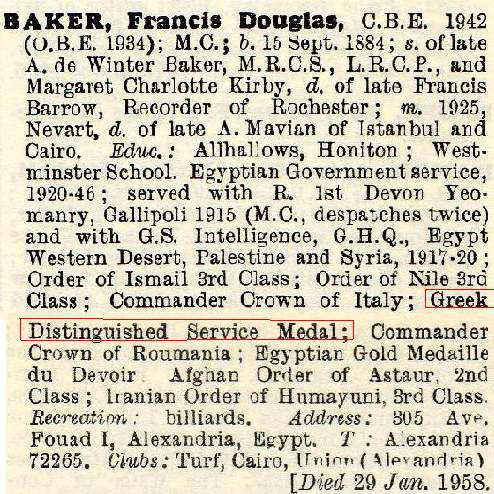 0
0 -
Hi Emmanuel,
Never mind.
Many thanks the same for your precious comments !
Best Regards
Lilo
0 -
When he got a First Class in 1929,this is a Grand Cross with sash badge & breast star with a dark blue sash.
Dear Emmanuel,
Thanks for the replay.
First, I must admit that after reading your first post, I re-checked what the other researcher wrote to me a propos of B-P Chilean awards so I recognised that there was a mistake/incomprehension :
B-P received only the : Chile Order of Merit Gold medal 1911 (Approved).
The entry '1st class London Gazette 9.8.1929' refers to the Hungarian, Order of Merit, NOT the Chilean one !
Regarding the B-P's ribbon bar, unfortunately, I haven't it or a photo of it.
My intention is to reproduce it, using old silk ribbons, after that my research on this and some other Orders, is finished.
Best Regards
Lilo
P.S.
I'll wait, with impatience, your posting of the photo of the 'Chile Order of Merit Gold Medal from the 1st Type, which is the same as the one Baden Powell got', that you saw in June 2005, in the auction in Germany.
0 -
This is a close-up from the Original Award Diploma.
Emmanuel
Hi Emmanuel,
First, I would let you know that I made the above question because I'm studying the full medal entitlement to Lord Baden Powell and would like to understand what is the correct ribbon that should go on his Chile, Order of Merit.
I was advised by a friend collector that in the file regarding the award of the Chile, Order of Merit to Baden Powell, held in the British National Archives, there is the following entry :
Chile Order of Merit Gold medal 1911 Approved
1st class London Gazette 9.8.1929
So apparently He received a Gold Star ('medal' in the papers) in 1911 and later a 1st class in 1929.
1)
Confronting what you have written, Dear Emmanuel, and what reported by the B-P papers at the archives, it seems to me to understand that B-P received what in 1911 was the Highest class (the GOLD Star) between the 3 classes awarded in the period 1906-1924, isn't it ?
2)
Regarding the sequence of the colours on the ribbon, you say that the 'Silver Cross' -with Blue enamell-(that if I have well understood correspond to the 2nd class in the period 1906-1924) awarded in 1909, has the following sequence of colours: White/Blue/Red.
You have also posted what seems to be a 'Gold Star' - with White enamell- (i.e. a 1st class in the period 1906-1924), similar to what I think to be awarded to Lord B-P also because it has the white enamell that I can see on the same Cross worn by B-P in the photos. This class appears to be suspended from a ribbon whose sequence of colours are the following : Blue/White/Red.
Is it wrong to suspect that the 1st class (GOLD Star, with 'WHITE' enamel) of this Order in the period 1906-1924, was suspended from a ribbon whose sequence of colours was Blue/White/Red, while the 2nd class (the SILVER Star, with 'BLUE' enamel) in the same period, was suspended from a ribbon whose sequence of colours was White/Blue/Red ?
Many Thanks in advance
Regards
Lilo
0 -
I suspect the Italians were trying to represent, however inaccurately and clumsily, the name of the medal? Why do you think this would NOT have been the case?
Hi Ed,
I haven't said that what was transcribed in the General's papers could not be erroneously reported by the clerk (although there is a large difference in spelling between 'Sega Kat' and 'Liyakat') but only asked if the two forum members could explain why they think that the medal received by the General was the Liyakat medal and not the IMTIYAZ MEDAL ?
Regards
Lilo
0 -
I bealive , it is a Gold Liyakat Medal awarded for the General Manera.
Date 1908 is ok , altough it was founded in 1890 (1308) by Sultan Abdulhamid (Ruled the Empire between 1876 to 1909) , it was awarded till the end of Ottoman Empire.
All the Best ,
Avsar
Hello Avsar,
Many thanks for your guess but can you explain because you think He received the Liyakat medal and not the IMTIYAZ MEDAL ?
Many thanks
Lilo
0 -
Hello,
It may be LIYAKAT medal. (If you have a picture it will be easier to identify.) The date on it is 1308 (1890). The date on the paper is showing the date of the document. The ribbon is red with green lines at the sides.
Best wishes
demir
Hi Demir,
Many thanks for your guess.
Please can you clarify :
1) because you think it is Liyakat medal and not the IMTIYAZ MEDAL ?
May be because the final part of the word 'KAT' coincide with that of the medal mentioned on the papers of Gen. Manera or what else ?
2) Which is more probable that He received the Gold or the Silver issue ? (it is not specified in the papers).
3) The date on the papers of the General for this medal is '1908' and this is the date when He received the medal.
4) Last if it can be of any importance, General Manera also received the Turkish Order of Medejie, Commander, in October 1908 on the same year of the award of the so called 'SEGA KAT' medal so I think that He received both contestually.
Awaiting to hear your (and others) comments
Best Regards
Lilo
0


Is it this Order that of Maria Christina ?
in Spain
Posted · Edited by lilo